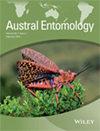Positions of Juvenile Stages of Culicoides brevitarsis Kieffer (Diptera: Ceratopogonidae) and of Four Other Flies in Bovine Dung
引用次数: 16
Abstract
A study was made of the positions of juvenile stages of Culicoides brevitarsis and of four other species of flies (Diptera) breeding in bovine dung. The objective was to provide information on sampling cores of dung for laboratory experiments and to study fly behaviour associated with the breeding habitat. Oviposition and field exposure of dung were restricted to 2 d and this enabled relatively discrete populations of flies to be investigated. All species were reasonably abundant after 2 d of oviposition. Distributions were contrasted by dividing the dung into vertical and horizontal segments. C. brevitarsis, A ustralosepsis niveipennis and Leptocera mirabilis oviposited mainly in the top of the dung, while Sepsis nitens and Psychoda sp. oviposited mainly in the lower half. After hatching, the proportions of flies varied between positions and over time. Except for C. brevitarsis, the adult flies were reared from the half of the pat associated with oviposition. C. brevitarsis and A. niveipennis rearings were evenly distributed in centre and outer positions 4 d after dung deposition and C. brevitarsis showed clear changes in vertical position over time. Moisture content in the dung decreased by 16.1% after 10 d, mainly in the upper half of the pat. Greater numbers of C. brevitarsis were associated with areas of higher moisture. The fly species varied in their times of emergence with C. brevitarsis emerging later in the lower half positions than in the upper half positions 10 d after deposition of the dung. A procedure for sampling cores of dung is proposed.牛粪中短纹库蚊幼虫(双翅目:蠓科)和其他四种蝇类幼虫的位置
研究了在牛粪中繁殖的短纹库蚊和其他四种双翅目蝇的幼期位置。目的是为实验室实验提供粪便取样芯的信息,并研究与繁殖栖息地有关的苍蝇行为。产卵和粪便的野外暴露被限制在2天内,这使得相对离散的苍蝇种群得以调查。产卵第2 d后,所有种类均相当丰富。通过将粪便分为垂直和水平部分来对比分布。C. brevitarsis、A . ustralosepsis niveipennis和lepptocera mirabilis主要在粪便的顶部产卵,而脓毒症和Psychoda sps主要在粪便的下半部分产卵。孵化后,苍蝇的比例随位置和时间而变化。除短螺旋体蝇外,其余成虫均在与产卵有关的一半部位饲养。粪便沉积4 d后,白氏假单胞菌和尼维氏假单胞菌在中心和外围位置分布均匀,白氏假单胞菌垂直位置随时间变化明显。10 d后,粪中水分含量下降16.1%,主要集中在粪的上半部分。更多数量的短叶白弧菌与较高湿度的地区有关。蝇类的羽化时间存在差异,在粪便沉积10 d后,短螺旋体在下半部分羽化较晚,上半部分羽化较晚。提出了一种粪芯取样方法。
本文章由计算机程序翻译,如有差异,请以英文原文为准。
求助全文
约1分钟内获得全文
求助全文

 求助内容:
求助内容: 应助结果提醒方式:
应助结果提醒方式:


